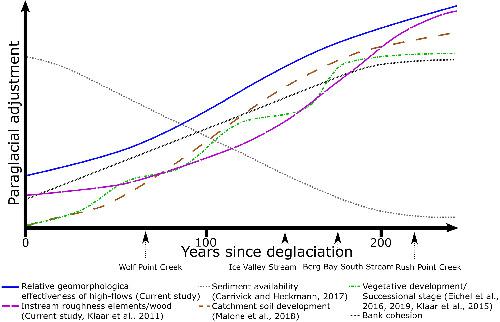当前位置:
X-MOL 学术
›
Earth Surf.Process. Land.
›
论文详情
Our official English website, www.x-mol.net, welcomes your
feedback! (Note: you will need to create a separate account there.)
Repeated high flows drive morphological change in rivers in recently deglaciated catchments
Earth Surface Processes and Landforms ( IF 2.8 ) Pub Date : 2021-02-18 , DOI: 10.1002/esp.5098 Lawrence J. B. Eagle 1 , Jonathan L. Carrivick 1 , Alexander M. Milner 2, 3 , Lee E. Brown 1 , Megan J. Klaar 1
Earth Surface Processes and Landforms ( IF 2.8 ) Pub Date : 2021-02-18 , DOI: 10.1002/esp.5098 Lawrence J. B. Eagle 1 , Jonathan L. Carrivick 1 , Alexander M. Milner 2, 3 , Lee E. Brown 1 , Megan J. Klaar 1
Affiliation

|
Climate change is decreasing glacier cover and increasing the frequency and magnitude of precipitation‐driven high flows and floods in many regions of the world. Precipitation may become the dominant water source for river systems in recently deglaciated catchments, with major rainfall events driving significant changes in river channel morphology. Few studies, however, have examined river channel response to repeated precipitation‐driven high flows. In this study, we measured the geomorphological condition of four low‐order rivers in recently deglaciated catchments (70–210 years ice free) before and after a series of repeated precipitation‐driven high flows during summer 2014. High flows drove substantial initial morphological change, with up to 75% change in baseflow channel planform position and active channel form change from pre‐ to post‐high flow. Post‐high flow years were associated with increased instream wood and geomorphological complexity at all but the youngest river. Channel changes were part of an active relaxation stage at all rivers, where channels continued to migrate, and complexity varied through time. Overall, these measurements permit us to propose a conceptual model of the role of geomorphologically effective high flows in the context of paraglacial adjustment theory. Specifically, we suggest that older rivers in recently deglaciated catchments can undergo a short‐term (<10 years) increase in the rate of geomorphological development as a result of the recruitment of instream wood and channel migration during and following repeated precipitation‐driven high flows. Enhancing our knowledge of these geomorphological and paraglacial processes in response to high flows is important for the effective management of riverine water and ecosystem resources in rapidly changing environments.
中文翻译:

不断重复的高流量推动了最近冰河集水区河流的形态变化
气候变化正在减少冰川覆盖,并在世界许多地区增加了降雨驱动的高流量和洪水的频率和强度。降雨可能成为最近冰河集水区河流系统的主要水源,主要的降雨事件推动了河道形态的重大变化。但是,很少有研究检查河道对反复降雨驱动的高流量的响应。在这项研究中,我们测量了在2014年夏季一系列反复降雨驱动的高流量前后,最近处于冰期的集水区(70-210年无冰)中的四个低阶河流的地貌条件。高流量推动了实质性的初始形态变化,从高流量到高流量,基准流通道平面位置和活动通道形状的变化最多可改变75%。高流量后的年份与除最年轻的河流以外的其他所有河流的木材增加和地貌复杂性有关。在所有河流中,河道变化是积极放松阶段的一部分,河道不断迁移,复杂度随时间而变化。总的来说,这些测量结果使我们能够提出一个概念模型,以模拟冰期调节理论的背景下地貌学上有效的高流量的作用。具体而言,我们建议在近期冰雪覆盖的集水区中较旧的河流可能会经历短期(< 10年)是由于反复降雨驱动的高流量期间和之后募集了流入木材和河道迁移而导致的地貌发展速度增加。应对高流量,增强我们对这些地貌和冰川作用过程的了解,对于在瞬息万变的环境中有效管理河流水和生态系统资源非常重要。
更新日期:2021-03-18
中文翻译:

不断重复的高流量推动了最近冰河集水区河流的形态变化
气候变化正在减少冰川覆盖,并在世界许多地区增加了降雨驱动的高流量和洪水的频率和强度。降雨可能成为最近冰河集水区河流系统的主要水源,主要的降雨事件推动了河道形态的重大变化。但是,很少有研究检查河道对反复降雨驱动的高流量的响应。在这项研究中,我们测量了在2014年夏季一系列反复降雨驱动的高流量前后,最近处于冰期的集水区(70-210年无冰)中的四个低阶河流的地貌条件。高流量推动了实质性的初始形态变化,从高流量到高流量,基准流通道平面位置和活动通道形状的变化最多可改变75%。高流量后的年份与除最年轻的河流以外的其他所有河流的木材增加和地貌复杂性有关。在所有河流中,河道变化是积极放松阶段的一部分,河道不断迁移,复杂度随时间而变化。总的来说,这些测量结果使我们能够提出一个概念模型,以模拟冰期调节理论的背景下地貌学上有效的高流量的作用。具体而言,我们建议在近期冰雪覆盖的集水区中较旧的河流可能会经历短期(< 10年)是由于反复降雨驱动的高流量期间和之后募集了流入木材和河道迁移而导致的地貌发展速度增加。应对高流量,增强我们对这些地貌和冰川作用过程的了解,对于在瞬息万变的环境中有效管理河流水和生态系统资源非常重要。











































 京公网安备 11010802027423号
京公网安备 11010802027423号